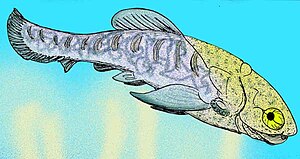Incisoscutum
| Incisoscutum | ||||||||||||
|---|---|---|---|---|---|---|---|---|---|---|---|---|

Live reconstruction |
||||||||||||
| Temporal occurrence | ||||||||||||
| Upper Devonian | ||||||||||||
| 365 million years | ||||||||||||
| Locations | ||||||||||||
| Systematics | ||||||||||||
|
||||||||||||
| Scientific name | ||||||||||||
| Incisoscutum | ||||||||||||
| Dennis & Miles , 1981 | ||||||||||||
| Art | ||||||||||||
|
||||||||||||
Incisoscutum (of lat . Incidere "cut", "dig in" and scutum "shield") is a genus of the extinct Placodermi , a group of armored, fish-like vertebrates, from the Devonian . She belongs to the group of Arthrodira .
The type species I. ritchiei was scientifically described for the first time in 1981 .
The holotype comes from the Australian Gogo Formation and is estimated to be 365 million years old. The fossil is kept under archive number WAM 03.3.28 in the Western Australian Museum in Perth . It has a length of approx. 10 cm.
In 2009 the remains of an approx. 5 cm long embryo were discovered in a specimen of I. ritchiei , showing that this placoderm was viviparous . Also in 2009 were found in a male fossil of I. ritchiei about 6 mm long clusters , an erectile mating organ. After the embryo finds in the Ptyctodontids Materpiscis attenboroughi and Austroptyctodus gardineri, there is further evidence of reproduction by copulation in placoderms. Internal fertilization therefore arose very early in the evolution of vertebrates .
Several hundreds of specimens kept in museums around the world had for a long time not given any indications of dimorphism in arthrodirs, unlike the related group of ptyctodontids . Therefore, the discovery made by I. ritchiei that there were clasps on the pelvic fins as long praises for copulation was all the more spectacular.
literature
- John A. Long: The Rise of Fishes: 500 Million Years of Evolution. University of New South Wales Press, Sydney 1995, ISBN 0-86840-078-5 . (also Johns Hopkins University Press, Baltimore, USA)
Individual evidence
- ↑ K. Dennis, RS Miles: A pachyosteomorph arthrodire from Gogo, Western Australia. In: Zoological Journal of the Linnean Society. 73, 1981, pp. 213-258.
- ↑ K. Bifield: A study of the structure and function of the post-cranial skeleton of two orders of placoderms: arthrodira and ptyctodontida. Bachelor thesis. University of Western Australia 2004. ( online ( Memento from February 17, 2011 in the Internet Archive ))
- ↑ JA Long, K. Trinajstić, Z. Johanson: Devonian arthrodire embryos and the origin of internal fertilization in vertebrates. In: Nature. 457, 2009, pp. 1124-1127. doi: 10.1038 / nature07732
- ↑ P. Ahlberg, K. Trinajstić, Z. Johanson, J. Long: Pelvic claspers confirm chondrichthyan-like internal fertilization in arthrodires. In: Nature. 460, 2009, pp. 888-889. doi: 10.1038 / nature08176
- ↑ JA Long, K. Trinajstić, GC Young, T. Send: Life birth period in the Devonian. In: Nature. 453, 2008, pp. 650-653. doi: 10.1038 / nature06966
- ↑ Archive link ( Memento of the original from September 16, 2009 in the Internet Archive ) Info: The archive link was inserted automatically and not yet checked. Please check the original and archive link according to the instructions and then remove this notice. Document from the Victoria Museum Melbourne
Web links
- How Incisoscutum Could Have Had Sex BBC
- Oldest Embryo Fossil Found livescience.com
- Pregnant Panzerfische Wissenschaft.de
- Introduction to Panzerfische (in English)
- More About Placoderms (in English)